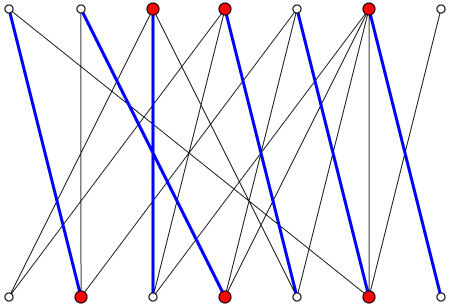König's Theorem (graph theory)
The set of King is a mathematical theorem from graph theory , which for bipartite graphs a relationship between a greatest pairing and a minimum vertex cover shows. It reads:
- In a bipartite graph, the size of a largest pairing is equal to the size of a minimum node coverage.
The theorem is named after the Hungarian mathematician Dénes Kőnig , who proved it in 1931. Independently of König, the mathematician Jenő Egerváry , also in 1931, proved a more general formulation of the theorem for weighted graphs . That is why the sentence is sometimes referred to as König and Egerváry's sentence.
example
An example of a bipartite graph, with the greatest pairing (blue) and the minimum vertex coverage (red):
algorithm
This algorithm describes how the minimum node coverage is obtained from a largest pairing. A largest pairing can be calculated, for example, using the Hopcroft and Karp algorithm. The two sets of nodes of the bipartite graph are denoted by (above) and (below).
- Calculate a largest match.
- All nodes from not included in the pairing are inserted into.
- We trace from these nodes to edges that are not included in the pairing . All visited nodes are inserted into.
- From the nodes reached in this way , we go back to the edges contained in the pairing . All visited nodes are inserted into.
- Repeat the previous two steps until no more nodes are added.
- The minimum node overlap results from
Variant for weighted graphs
Independently of König, the mathematician Jenő Egerváry proved a variant of the theorem for weighted graphs . Here we consider bipartite graphs with a weight function that assigns a nonnegative integer to each edge in the graph. A weighted vertex coverage of is a function that assigns a nonnegative integer to every vertex in the graph, so that applies to all edges . The weight of is given by. The sentence then reads as follows:
- In a complete bipartite graph with and a weight function , the maximum weight of a pairing corresponds to the minimum weight of a weighted node cover of .
Individual evidence
- ^ Klaus Wagner: Graph theory. Bibliographisches Institut Hochschultaschenbücher, Mannheim 1970, ISBN 3-411-00248-4 , sentence 9.9
- ↑ Jenő Egerváry: Matrixok kombinatorius tulajdonságairól . In: Matematikai és Fizikai Lapok . tape 38 , 1931, p. 16-28 . (On combinatorial properties of matrices)
- ↑ a b Harold W. Kuhn: On combinatorial properties of matrices . In: George Washington University (Ed.): Logistics Papers . tape 11 , 1955, pp. 1-11 .
Web links
- Eric W. Weisstein : König-Egeváry Theorem . In: MathWorld (English).
- Proof of König's Theorem (PDF; 286 kB)













